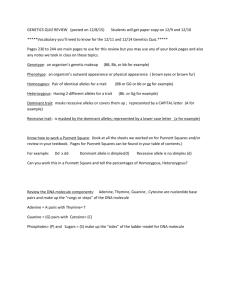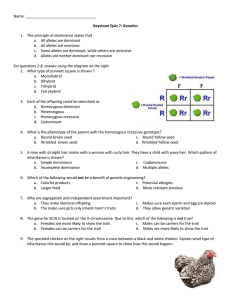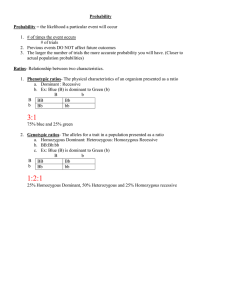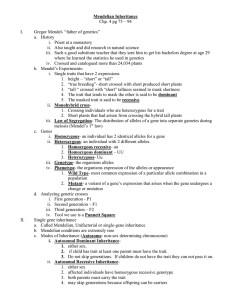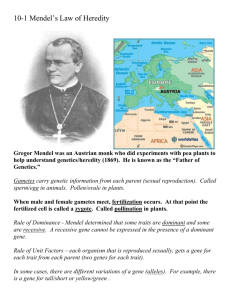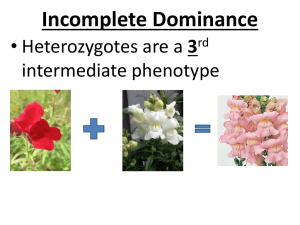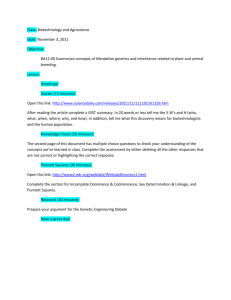Mendelian Inheritance Chp. 4 pg 75 – 94 I.
advertisement
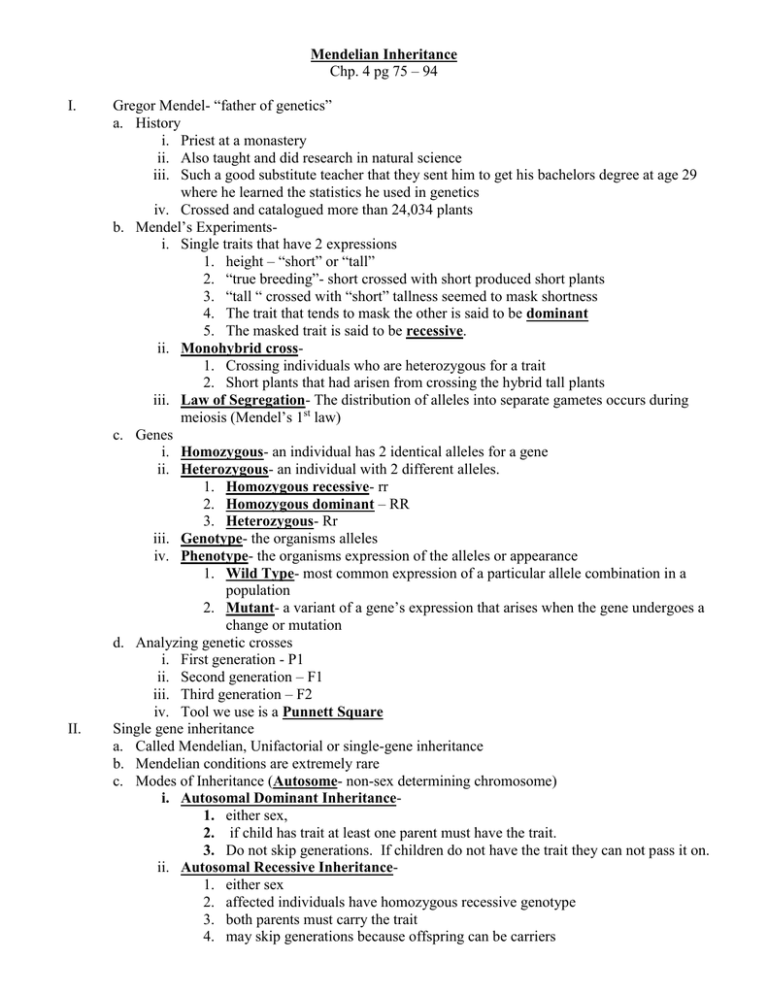
Mendelian Inheritance Chp. 4 pg 75 – 94 I. II. Gregor Mendel- “father of genetics” a. History i. Priest at a monastery ii. Also taught and did research in natural science iii. Such a good substitute teacher that they sent him to get his bachelors degree at age 29 where he learned the statistics he used in genetics iv. Crossed and catalogued more than 24,034 plants b. Mendel’s Experimentsi. Single traits that have 2 expressions 1. height – “short” or “tall” 2. “true breeding”- short crossed with short produced short plants 3. “tall “ crossed with “short” tallness seemed to mask shortness 4. The trait that tends to mask the other is said to be dominant 5. The masked trait is said to be recessive. ii. Monohybrid cross1. Crossing individuals who are heterozygous for a trait 2. Short plants that had arisen from crossing the hybrid tall plants iii. Law of Segregation- The distribution of alleles into separate gametes occurs during meiosis (Mendel’s 1st law) c. Genes i. Homozygous- an individual has 2 identical alleles for a gene ii. Heterozygous- an individual with 2 different alleles. 1. Homozygous recessive- rr 2. Homozygous dominant – RR 3. Heterozygous- Rr iii. Genotype- the organisms alleles iv. Phenotype- the organisms expression of the alleles or appearance 1. Wild Type- most common expression of a particular allele combination in a population 2. Mutant- a variant of a gene’s expression that arises when the gene undergoes a change or mutation d. Analyzing genetic crosses i. First generation - P1 ii. Second generation – F1 iii. Third generation – F2 iv. Tool we use is a Punnett Square Single gene inheritance a. Called Mendelian, Unifactorial or single-gene inheritance b. Mendelian conditions are extremely rare c. Modes of Inheritance (Autosome- non-sex determining chromosome) i. Autosomal Dominant Inheritance1. either sex, 2. if child has trait at least one parent must have the trait. 3. Do not skip generations. If children do not have the trait they can not pass it on. ii. Autosomal Recessive Inheritance1. either sex 2. affected individuals have homozygous recessive genotype 3. both parents must carry the trait 4. may skip generations because offspring can be carriers III. IV. I. Inheritance of 2 genes- Independent Assortment a. Law of Independent Assortment (Mendel’s 2nd Law)- The inheritance of one gene does not influence the chance of inheriting the other b. Mendel’s Experimentsi. Traits- seed shape (R gene) and seed color (Y gene) ii. Crossed “true breeding” round, yellow plants with “true breeding” wrinkled, green plants and all progeny had round yellow seeds iii. These offspring where double heterozygotes (RrYy) iv. Round is dominant to wrinkled, Yellow dominant to green c. Use a Dihybrid Cross- (Fig. 4.10) a cross of individuals who are heterozygous for two traits Pedigree Analysis- (Fig. 4.13 – legend of symbols and examples) a. Pedigree- Charts used to display family relationships and to follow which relatives have specific phenotypes and sometimes genotypes. Punnett Squares-A diagram that predicts the expected outcome of a genetic cross a. Steps for completing an Punnett square: i. Determine the genotypes you need to cross. ii. Put the female (♀) genotype on the top of the Punnett square iii. Put the male (♂) down the side of the Punnett square iv. Put the dominant allele (the capitol letter) first, if one is present. v. Put the recessive allele (the lower case letter) second, if one is present Example 1: ♀ A a ♂ A AA Aa a Aa aa II. Probability = the likelihood a particular event will occur a. # of times the event occurs # of trials b. Previous events DO NOT affect future outcomes c. The larger the number of trials the more accurate probability you will have. (Closer to actual population probabilities) III. Ratios- Relationship between two characteristics. a. Phenotypic ratios- The observable physical characteristics of an organism presented as a ratio i. Dominant : Recessive ( 3:1 above) b. Genotypic ratios- The alleles for a trait in a population presented as a ratio i. Homozygous Dominant : Heterozygous : Homozygous Recessive (1:2:1 above)
